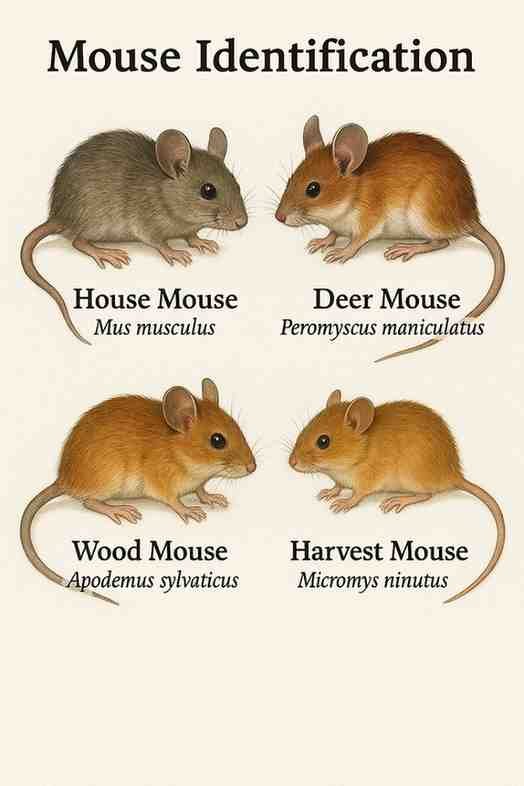What is the scientific name for a mouse? The house mouse scientific name is Mus musculus.
The scientific name for the mouse is one of the most commonly asked questions in biology and zoology. These small mammals are mostly encountered in homes, laboratories, and the wild. However, very few people know the biological name of a mouse, its classification, and even the meaning of that zoological name.
In the article, we will discuss the mouse scientific name, the house mouse’s scientific name, genus, classification, pronunciation, and related species. All information is based on real facts and standard taxonomy.
Table of Contents
What Is the Scientific Name of a Mouse?
The mouse’s scientific name is preferably written as Mus musculus. This name is recognized internationally for the house mouse, the most common species in human surroundings.
- Genus: Mus
- Species: musculus
Together, they form the mouse’s full scientific name, Mus musculus.
This scientific naming system falls under binomial nomenclature, whereby every species is given a two-part Latin name. The mouse’s scientific name thus helps any researchers, scientists, or professionals identify and classify this species with no confusion.
Pronunciation and Meaning of Mouse Scientific Name
Pronunciation of Mus musculus
- Mus: rhymes with the word, buhs [muhs]
- musculus: Pronunciation [MUS-kyuh-luhs] or [MUS-kuh-luhs]
Meaning of Mouse Scientific Name
Mus is Latin for mouse; musculus means “little mouse,” or small muscle. The species name indicates that the animal is small compared to other mammals.
Thus, the scientific name for the mouse, Mus musculus, literally translates as “small mouse.”
House Mouse Scientific Name and Why It Matters
The scientific name for the house mouse would again be Mus musculus. This species finds a living in houses, buildings, and farms. It often survives on scraps of food and gets very close to humans.
Why Is House Mouse Scientific Name Important?
The scientific name of the mouse thus helps to:
- Identify the right species in research.
- Avoid confusion with other types of mice.
- Maintained accuracy in laboratory experiments.
- Keeping data in pest control and wildlife studies.
Also, understanding diseases that mice can carry and spread in the house, their scientific name.
Mouse Scientific Classification Table
This is a complete biological classification of a mouse:
| Classification Level | Classification Name |
|---|---|
| Kingdom | Animalia |
| Phylum | Chordata |
| Class | Mammalia |
| Order | Rodentia |
| Family | Muridae |
| Genus | Mus |
| Species | musculus |
This classification defines the mouse’s position in the animal kingdom and shows its relationship to other mammals and rodents(Rat).
Types of Mice and Their Genus Names
Mus is the genus of the mouse. It contains many small rodents, the most well-known of which is Mus musculus, the house mouse.

Other species within the same genus include:
- Mus spretus: The western European mouse
- Mus spicilegus: Mound-building mouse
- Mus macedonicus: Macedonian mouse
There are different species of mice in the genus Mus, but the general house mouse is referred to by the scientific name Mus musculus.
Different Varieties of Mice and Their Scientific Names
Mice come in many types, not all belonging to the genus Mus, but they are usually still called “mice” in general terms. Here are some samples:
- Deer Mouse: Peromyscus maniculatus
- The deer mouse is a wild mouse species that is not a house mouse. These are found in North America and belong to a different genus.
- Field Mouse: Apodemus sylvaticus
- The field mouse is commonly found in Europe, living in grass fields and forests.
- Spiny Mouse: Acomys cahirinus
- Spiny mice have rough-spiny fur found in Africa and the Middle East.
Note: All these mouse species have different scientific names, but Mus musculus is the scientific name specific to the house mouse.
Common Usages of the Mouse Scientific Name
Scientific Research
Mice are kept in laboratories worldwide to study genetics, biology, and disease. When scientists work with a mouse as a lab animal, they always refer to the mouse’s scientific name, Mus musculus.
Pest Control
In pest control, knowing the scientific name of a house mouse is important. It distinguishes the species for pest control services, which might require different treatment mechanisms.
Academic Education
Students in schools and colleges learn the biological name of the mouse in their biology textbooks. This way, they come to know the taxonomy and classification of animals.
Interesting Facts About House Mouse
| Attribute | Details |
|---|---|
| Mouse Scientific Name | Mus musculus |
| Common Name | House Mouse |
| Average Weight | 12–30 grams |
| Body Length | 6–10 cm (2.4–4 inches) |
| Tail Length | 5–10 cm (2–4 inches) |
| Total Length | 11–20 cm (4.3–7.8 inches) |
| Color Variants | Grey, light brown, white (albino in labs) |
| Lifespan | 1–2 years (in wild), up to 3 years (in lab) |
| Habitat | Urban homes, fields, warehouses, laboratories |
| Diet | Seeds, grains, fruits, human food waste |
| Activity | Nocturnal (active at night) |
| Reproduction Rate | 5–10 litters per year, 5–12 pups per litter |
| Speed | Can run up to 8 miles per hour |
| Senses | Strong hearing and smell, weak eyesight |
| Tail Function | Helps with balance and temperature regulation |
| Mouse Genus | Mus |

